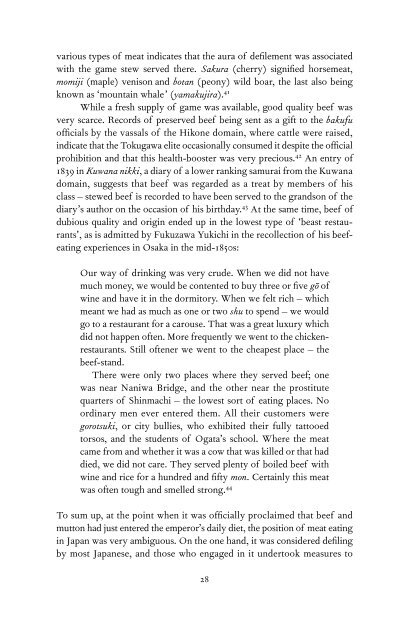Download - Brainshare Public Online Library
Download - Brainshare Public Online Library
Download - Brainshare Public Online Library
Create successful ePaper yourself
Turn your PDF publications into a flip-book with our unique Google optimized e-Paper software.
various types of meat indicates that the aura of defilement was associated<br />
with the game stew served there. Sakura (cherry) signified horsemeat,<br />
momiji (maple) venison and botan (peony) wild boar, the last also being<br />
known as ‘mountain whale’ (yamakujira). 41<br />
While a fresh supply of game was available, good quality beef was<br />
very scarce. Records of preserved beef being sent as a gift to the bakufu<br />
officials by the vassals of the Hikone domain, where cattle were raised,<br />
indicate that the Tokugawa elite occasionally consumed it despite the official<br />
prohibition and that this health-booster was very precious. 42 An entry of<br />
1839 in Kuwana nikki, a diary of a lower ranking samurai from the Kuwana<br />
domain, suggests that beef was regarded as a treat by members of his<br />
class – stewed beef is recorded to have been served to the grandson of the<br />
diary’s author on the occasion of his birthday. 43 At the same time, beef of<br />
dubious quality and origin ended up in the lowest type of ‘beast restaurants’,<br />
as is admitted by Fukuzawa Yukichi in the recollection of his beefeating<br />
experiences in Osaka in the mid-1850s:<br />
Our way of drinking was very crude. When we did not have<br />
much money, we would be contented to buy three or five gō of<br />
wine and have it in the dormitory. When we felt rich – which<br />
meant we had as much as one or two shu to spend – we would<br />
go to a restaurant for a carouse. That was a great luxury which<br />
did not happen often. More frequently we went to the chickenrestaurants.<br />
Still oftener we went to the cheapest place – the<br />
beef-stand.<br />
There were only two places where they served beef; one<br />
was near Naniwa Bridge, and the other near the prostitute<br />
quarters of Shinmachi – the lowest sort of eating places. No<br />
ordinary men ever entered them. All their customers were<br />
gorotsuki, or city bullies, who exhibited their fully tattooed<br />
torsos, and the students of Ogata’s school. Where the meat<br />
came from and whether it was a cow that was killed or that had<br />
died, we did not care. They served plenty of boiled beef with<br />
wine and rice for a hundred and fifty mon. Certainly this meat<br />
was often tough and smelled strong. 44<br />
To sum up, at the point when it was officially proclaimed that beef and<br />
mutton had just entered the emperor’s daily diet, the position of meat eating<br />
in Japan was very ambiguous. On the one hand, it was considered defiling<br />
by most Japanese, and those who engaged in it undertook measures to<br />
28







